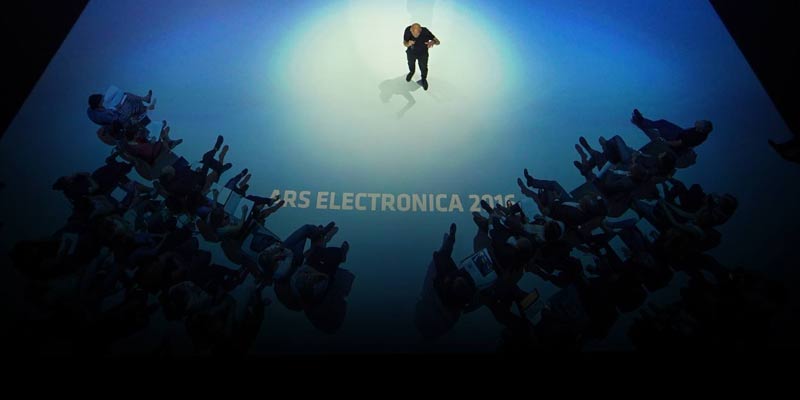New exhibition at the Ars Electronica Center
Creative Robotics
(Linz, February 3, 2016) “If every tool could perform its own work when ordered, or by seeing what to do in advance, […] master-craftsmen would have no need of assistants and masters no need of slaves.” What was once only a utopia for Aristotle is now being prognosticated for Western societies by observers at eminent institutions. It is said that over the course of a fourth Industrial Revolution—so-called Industry 4.0—robots and Big Data are going to mesh and thereby impart a new quality to the degree of automation, interaction and communication of machines among themselves and, by no means least of all, the collaboration of human beings with such machines. Regardless of which experts are ultimately proven to have been right as to whether hundreds of thousands of jobs will have been eliminated or new ones created, whether the forecasted productivity increases that often seem like pipedreams actually do pan out, and whether the internet of things brings about the total transparency of its users or society ultimately does succeed in safeguarding individuals’ privacy, one thing is for sure: these looming developments will definitely have massive social, economic and political consequences. “Creative Robots,” an exhibition produced jointly by the Department of Robotics at Johannes Kepler University Linz, the Robot Lab at Linz Art University, the University of Applied Arts Vienna’s Robotic Woodcraft research project, the international Association for Robots in Architecture, KUKA CEE GmbH and the Ars Electronica Center, offers a preview of what robots might well be doing in the near future. After all, there can be no doubt that robots won’t be confined to conventional assembly lines for very much longer.
Creative Robotics
Light Painting with the KUKA KR16 / Chris Noelle, Linz Art University, KUKA CEE GmbH
Industrial robots are usually deployed to handle, install or process various objects. The KUKA KR16 is just such a robot. Compact in size with a maximum load capacity of 16 kilograms, it’s perfectly suited for easy tasks like testing components, grinding, polishing and installing small parts. And in an artistic context too, the KR16 is an absolute genius now that the Robot Lab at Linz Art University has developed an app that enables it to create light paintings. To make this happen, a light source is moved as quickly as possible, and the resulting lines and forms are captured by means of time-exposure photography and then displayed. The process was designed and choreographed by light painter Chris Noelle. Since you can’t tell whether all the lines were rendered correctly until you view the finished picture, a robot has a big advantage over a human being here because its motions can be precisely programmed in advance.
Robotic Woodcraft / Philipp Hornung, University of Applied Arts Vienna and Association for Robots in Architecture
Robotic Woodcraft is an R&D project carried out by the University of Applied Arts Vienna in collaboration with the Association for Robots in Architecture. Architects, cabinetmakers, mathematicians and designers aim to experiment with ways to integrate high-tech robotics into high-end wood processing. To this end, a KUKA robot that can lift up to 120 kilograms and extend its arm 2.5 meters in all directions was set up in the University of Applied Arts’ Department of Wood Technology. The robot’s arm is multifunctional—for instance, it can morph from a milling machine into a 3-D printer. The installation at the Ars Electronica Center features Philipp Hornung’s degree project: an initial prototype of an innovative hybrid ultra-light framework that this robot can produce and assemble in only three days. The complex spatial structure is made up of 4-millimeter-thick pieces of plywood. It spans several meters and weighs only 25 kilos.
Self-stabilizing Balancing Cube / Johannes Kepler University Linz
How playful dealing with robots can be is demonstrated by a project carried out at Linz Art University’s Robot Lab: a cube that balances on one corner on its own and, as if by magic, simply doesn’t topple over. The secret component that makes it hard to destabilize is a built-in gyroscope. The physics behind this is the principle of the conservation of angular momentum that we’re familiar with from the pirouettes performed by figure skaters.
Robotic Calligraphy with the KUKA IIWA / Linz Art University, Association for Robots in Architecture, RWTH Aachen University and KUKA CEE GmbH
KUKA’s intelligent industrial work assistant (iiwa) is a member of the next generation of robots that can work safely together with human beings. At Linz Art University’s Robots Lab, the iiwa has been taught a new skill. It snaps a photo and then computes the brightness of each individual pixel. Mounted on the tip of the robot’s arm is a calligraphy pen, one end of which is tapered to a point and the other end is squared off. When the pixel is bright, the robot draws with the fine nib; when the point of light is darker, it switches to the blunt nib. Using this rendering technique, the iiwa can generate a “robotic selfie” of any installation visitor in only a few minutes time.
http://www.flickr.com/photos/arselectronica/24475565480/
Light Painting / Fotocredit: Florian Voggeneder / Printversion / Album
http://www.flickr.com/photos/arselectronica/24673075532/
Self-Stabilizing Balancing Cube / Fotocredit: Robert Bauernhansl /Printversion / Album
http://www.flickr.com/photos/arselectronica/24164038413/
Robotic Calligraphy with the KUKA IIWA / Fotocredit: Robert Bauernhansl / Printversion / Album

